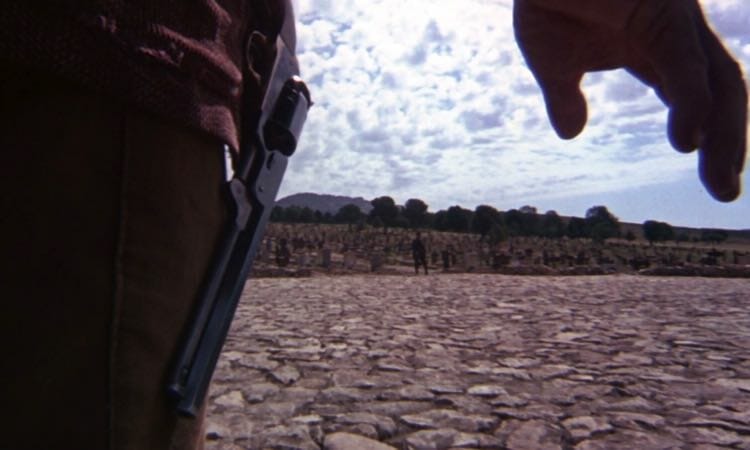By Matthew Pizana · November 1, 2014

The Good, the Bad and the Ugly, the third of three films in the “Dollars Trilogy” made by Sergio Leone, is a film school perfect example of the great spaghetti westerns of the 1960’s. Sergio Leone set out to make a Western that reflected the grim nature of the west rather than the superfluous films Hollywood had been churning out at the time. The story of bad guys, loads of money, and an unforgivingly harsh trek across the desert solidified Leone as a masterful filmmaker and an influence on directors for decades to come (cough, cough Tarantino).
Angel Eyes (Lee Van Cleff) learns of a hidden cache of Confederate gold and sets out to find a man named Bill Carson who is the key to finding the money. Clint Eastwood is Blondie, a drifter traveling across the plains of the wild west, trying to make as much money as he can by whatever means necessary. Tuco (Eli Wallach) is Blondie’s occasional business associate who plays the bait in a ruse to rip off reward money for Tuco’s capture. Their partnership works until Blondie determines that Tuco has maxed out his value and leaves him in the desert while Blondie drifts off to his next money making venture. Tuco makes it out of the desert and comes looking for Blondie eventually returning the favor by hauling Blondie across any even more barren landscape. The trip is sidetracked by a runaway stagecoach where Tuco discovers what cemetery the money is hidden in while Blondie learns what grave the money is buried in. Neither wanting to give up their bit of knowledge, they head off together to get the gold. Before they can ultimately battle over ownership, they have to venture through a battlefield of death and carnage just to get to the cemetery. Angel Eyes meets them at the cemetery and all three have an epic showdown to decide who gets the loot.
Revenge is important to the outlaws of The Good,the Bad and the Ugly but greed always wins the day. After being left in the desert by his old friend, Tuco’s only motivation is getting some good old fashioned eye for an eye revenge until he learns that Blondie has valuable knowledge about the gold forcing the duo into a tenuous business relationship. Angel Eyes follows his greed through numerous states, any number of different cavalries of military men, and ultimately to an early grave. There are only bad guys around the world of The Good, the Bad and the Ugly. Even Blondie, the good as referenced to in the title, ends up killing twice as many men as Angel Eyes or Tuco does.
Shooting on special film stock designed to get a wider image on the screen, Sergio Leone wanted the expansive west to be put on full display. Across never ending barren deserts to an entire battlefield, The Good, the Bad and the Ugly is an all encompassing experience. In spite of this, there are still several key moments that take place just off camera and out of the view of the audience as well as the characters. Blondie and Tuco are blinded by dollar signs and completely miss an entire battle being staged over control of a bridge just off the trail they walk down. When Tuco and Blondie arrive at the cemetery, Angel Eyes is able to sneak up on them even though he should have been visible to them from miles away. Needless to say, the ideal viewing experience cannot be found on an iPad or a cell phone.
With The Good, the Bad and the Ugly, Sergio Leone created a Western that was not sugar-coated Hollywood style, but rather a violent reflection of life as men trying to make it by any means necessary. Not only was The Good,the Bad and the Ugly great for Leone, it helped propel Clint Eastwood into being a cultural icon. The legacy of a man with no allegiances to anyone or anything, but money still runs strong on Wall Street, in politics, and anywhere you might find the top one percent. That’s the American way.